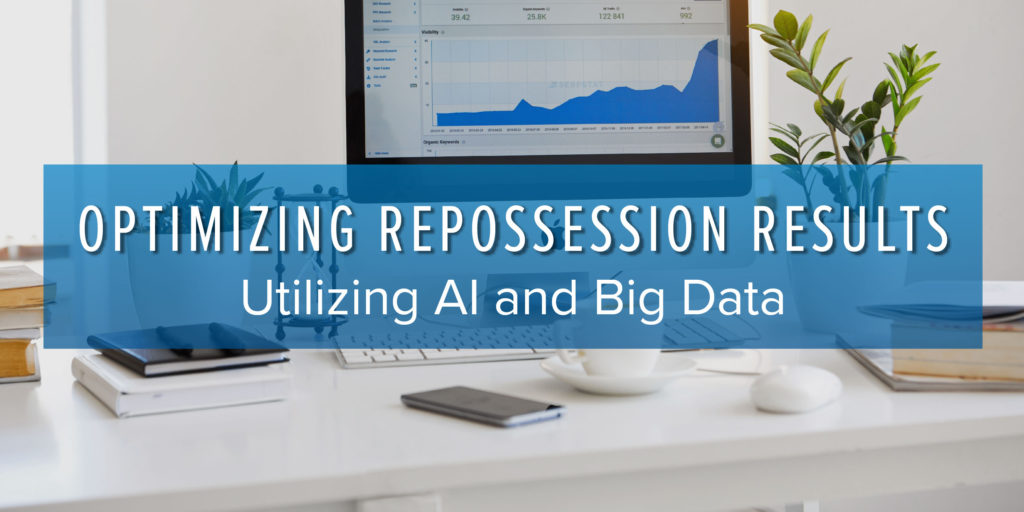
Optimizing Repossession Results Utilizing AI and Big Data
The characters in “The Wizard of Oz” ultimately learn that the items they had been seeking — courage, a heart, and a brain — were with them all along. They just needed to look inside themselves and realize the situations they had faced helped reveal those characteristics they thought they did not have. As Glinda tells Dorothy, “You’ve always had the power my dear, you just had to learn it for yourself.”
Auto lenders are very much the same way, especially with respect to their repossession portfolios. The answers to many of their challenges in seeking to improve recovery rates and efficiencies is to better utilize the mountains of data that they and their service providers have at their disposal. Deploying new technology, including artificial intelligence, can make that analysis easier and more powerful than ever before.
A key component to effectively leveraging data and developing a process to analyze the right data starts with knowing what data to look at. One good place to start is analyzing historical recovery at the portfolio level by agent. Charting the cumulative recovery rate over time — how many days since the repossession order was placed with an agency — will yield a recovery curve that shows when it is time to apply new tactics to try and find vehicles. That could mean deploying different tactics (i.e. more skip work) or assigning the order to another agency altogether. Those adjustments will often yield an uptick to an agency’s recovery rates. Analyzing historical data will give you a better estimate of recovery rates and timing, and allow the agency to plan and allocate resources as necessary. If you know that a certain agency is not effective after an account has been there for 15 days, you know to move that account somewhere else once that window has closed. The longer you wait before switching, the less likely you are to be successful at recovering the vehicle.
There is an old saying that a definition of insanity is doing the same thing over and over again and expecting different results. That saying holds true for the repossession industry. Having agents drive by the same addresses night after night is not always going to be the best solution to try and locate and recover a vehicle out for repossession. Lenders absolutely need to see data analysis as the silver bullet to help their repossession operations be more effective. The data is there, it just needs to be utilized properly. Work smarter, not harder, they say.
Along with analyzing historical data, auto finance operations can greatly benefit from data generated by License-Plate Recognition (LPR) systems. LPR has proven to be one of the most effective technological tools for the repossession industry at boosting recovery rates, especially as a recovery curve flattens when it becomes harder to find a vehicle as the length of time the order has been outstanding increases. LPR offers a whole new set of data points to analyze. The data from scans and hits can be invaluable in helping triangulate and prioritize assignments. A well-maintained and well-analyzed LPR database can be a lender’s most valuable asset.
When you are really ready to drill down into analyzing your data, you should start to look at trends within your geographic footprint. The more granular, the better. Starting a state level and then drilling down into specific ZIP codes can yield tremendous insights into recovery rates of different repossession agencies and national repossession companies and other key performance indicators. Repossession agencies may cover an entire state, but there are likely ZIP codes within that state where some are more effective than others. And knowing which agent or national repossession company is best in which ZIP code offers a huge leg up in boosting recovery rates and efficiencies. The deeper the drill down into geographic trends, the more insightful and impactful the results of the analysis will be.
One should also look at how recovery agencies and national repossession companies, also known as forwarders, perform based on the stage of delinquency (i.e. pre vs. post charge off). Different agencies and national repossession companies are going to be better at certain types of accounts. Analyzing data to determine this will result in higher recovery rates. While one provider may have the best score in a given state, if you look at that providers results at a more granular level, you will likely see different results.
An overall recovery rate for a repossession agency is not nearly as useful as being able to determine how likely an agency is going to be at recovering a vehicle based on the specific ZIP code or the age of the debt. Precision analysis will result in higher recovery rates, will recover vehicles faster, and will lead to higher liquidation returns.
Utilizing providers that can harness the power of the data will not only help lenders more effectively track and place assignments to try and achieve the highest recovery rates, but can provide insights on the front-end, before an account is placed. Scoring an account to determine the likelihood that a vehicle will be repossessed can save countless hours by determining which accounts should be placed where and when. The technology allows for lenders to create a continuous loop of improvement, with more data yielding better results and better results leading to more data. Optimizing your portfolio through the use of technology tools is perhaps the single-best improvement that a lender can make.
Auto lenders should constantly be looking for ways to improve their operations. Working with partners that can harness the lender’s data will yield meaningful results.
